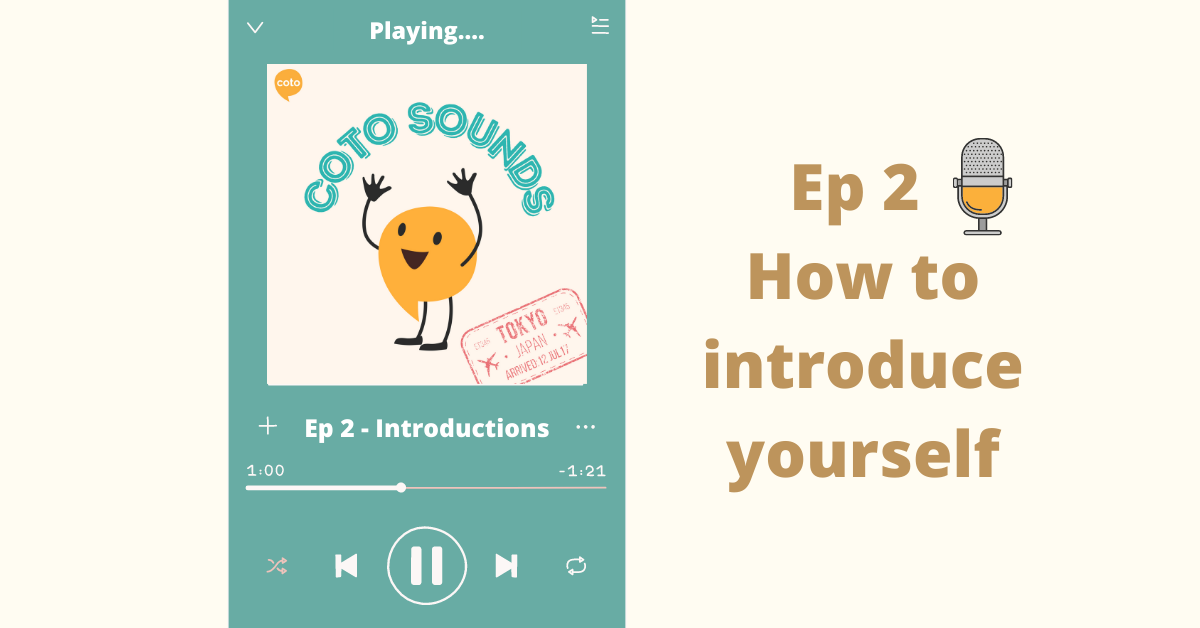Listening to language learning podcasts on a daily basis creates a regular habit for you to squeeze in some study time in your busy lives. Just listening to our 5 minute conversation can help you to also strengthen your Japanese listening skills and comprehension.
What’s even more effective for your learning is to listen to our podcast first, then following the transcript for the second time to confirm if you have understood the conversation. If just listening to Coto Sounds is challenging, reading the transcript can help you to review unfamiliar phrases and words.
Coto Sounds episodes are composed of the conversation, followed by a breakdown of the conversation translating it in English, and finishing off with some key vocabularies to take away from the conversation.
In Ep 2 – Introductions, the conversation includes:
- 00:19 2 people introducing themselves to each other
- 00:36 How to ask another person where they’re from
- 00:46 How to ask another person what they’re studying
- 00:57 How to ask another person why they’re studying that subject
- 01:07 How to ask how long they’ve been studying
- 01:38 English translation of the conversation
- 04:16 Key vocabulary to know
Transcript
A: 初めまして、私は田中です。私は大学生です。
どうぞよろしくお願いします。
hajimemashite, watashi wa tanaka desu. watashi wa daigakusei desu.
dōzo yoroshiku onegaishimasu
Hello, my name is Tanaka. I am a university student.
Nice to meet you.
B: 初めまして、私はエマです。私も同じく大学生です。
どうぞよろしくお願いします。
hajimemashite, watashi wa ema desu. watashi mo onajiku daigakusei desu.
douzo yoroshiku onegai shimasu
Hello, my name is Emma. I am also a university student. Nice to meet you.
Here you can see there is a template you have to follow when giving a self-introduction. You first say 初めまして (hajimemashite), this literal meaning is the first time, but translates to nice to meet you. The self-introduction is ends with どうぞよろしくお願いします (douzo yoroshikuonegaishimasu). This is another deeper meaning of nice to meet you, telling the other that they are looking forward to our relationship.
A:ところで、エマさんはどこの出身ですか?
tokorode, ema san wa doko no shusshin desuka?
Where are you from?
B:私はイギリス出身です。
watashi wa igirisu shusshin desu.
I am from England
A:あ、なるほど。ちなみエマさんは何を勉強していますか?
a, naruhodo, chinamini ema san wa nani wo benkyō shite imasuka
I see, what are you studying?
B: 私は日本語を勉強しています。
watashi wa nihongo wo benkyō shite imasu
I am studying Japanese.
A: そうなんですね、なぜ日本語を勉強したいと思ったのですか?
sounandesune, naze nihongo wo benkyō shitai to omotta no desuka?
Why are you studying Japanese?
B: 日本の文化に興味があるから、日本語を勉強しています。
nihon no bunka ni kyōmi ga arukara,
nihongo wo benkyō shitei masu.
I was interested in Japanese culture,
that is why I am studying Japanese.
A: なるほど、どれくらい勉強していますか?
naruhodo, dore kurai benkyō shite imasuka?
How long have you been studying Japanese?
B:もう半年くらい勉強をしています。
mou hantoshi kurai benkyō wo shite imasu.
It has been about half a year.
A: そうですか。がんばってください! あ、いけない、
あと5分で授業が始まります。また後でお話しましょう。
soudesuka. ganbatte kudasai! a, ikenai,
ato go fun de jugyō ga hajimarimasu. mata ato de ohanashimashou
I see. Keep it up! Oh no, class will be starting in 5 minutes. Let’s talk again later.
B:はい。また話しましょう。
hai. mata hanashi mashou
Yeah, let’s talk again.
Key vocabularies to know :
- 大学生 (daigakusei) – university student
- 出身 (shusshin) – origin
- 勉強 – study
- 話す – to talk
We hope this episode has helped with understanding more Japanese conversations and phrases.
Coto Sounds is available on:
If you have enjoyed the conversation and are looking for more, please leave a review for us on Apple Podcast! We would really appreciate your feedback into creating more learning opportunities for you!
Learn more about introducing yourself in Japanese here:
